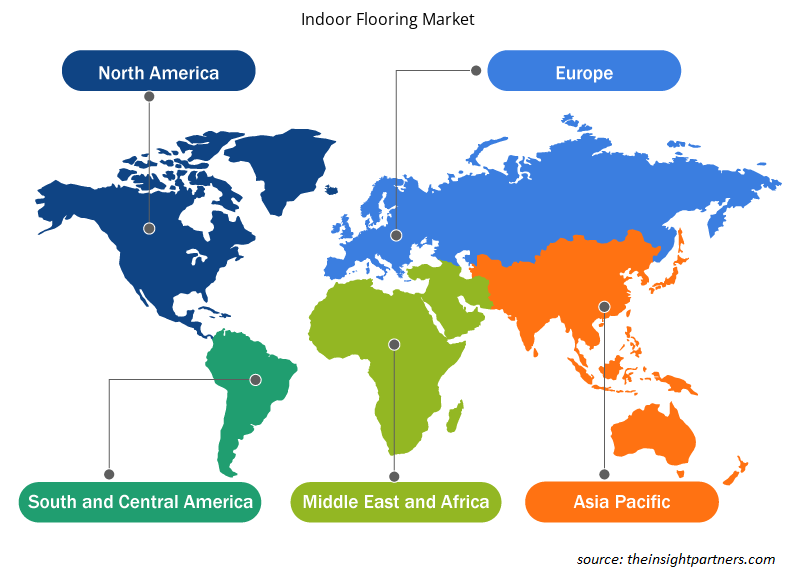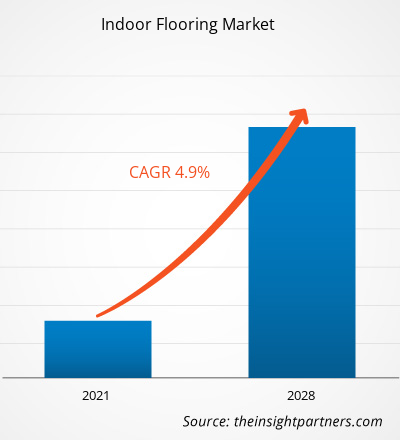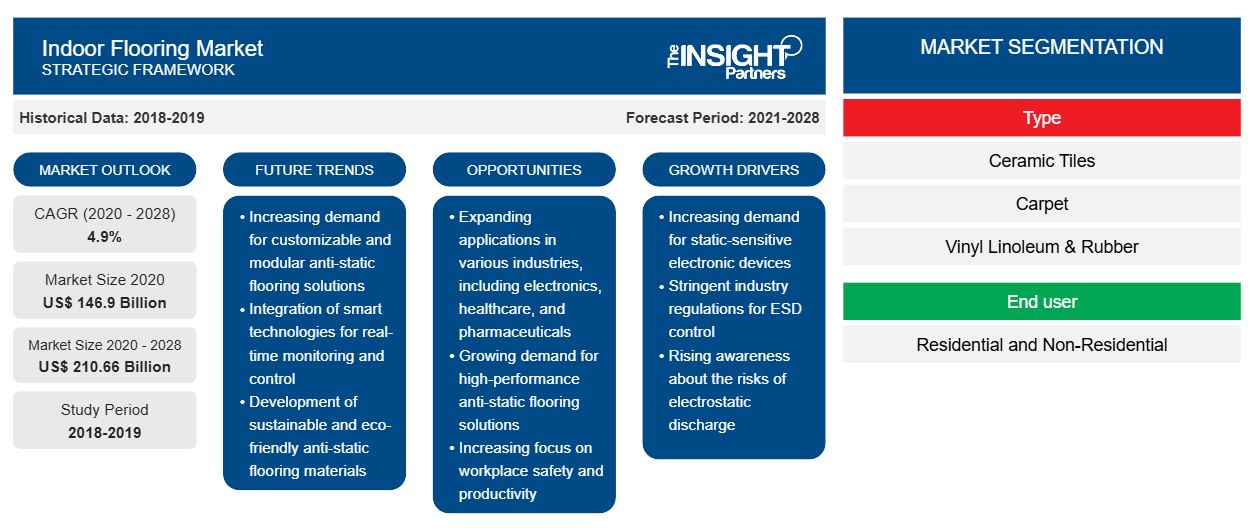[Rapporto di ricerca] Il mercato dei pavimenti per interni è stato valutato a 146,90 miliardi di dollari nel 2020 e si stima che crescerà a un CAGR del 4,9% durante il periodo di previsione dal 2021 al 2028.
In ambienti industriali quali magazzini, hangar per aeroplani, stabilimenti di assemblaggio, officine di verniciatura, carrozzerie e impianti di distribuzione, i pavimenti in calcestruzzo sono soggetti a usura a causa dell'esposizione a sostanze chimiche e oli aggressivi e corrosivi; possono inoltre essere danneggiati da graffi e abrasioni causati da macchinari e attrezzature pesanti come aeroplani e carrelli elevatori.
La rapida industrializzazione e l'istituzione di impianti di produzione e lavorazione nelle economie in via di sviluppo nell'APAC sta guidando la domanda di rivestimenti per pavimenti, e i settori farmaceutico, alimentare e delle bevande e dell'assemblaggio automobilistico sono i principali generatori di domanda. Le multinazionali in Europa e America stanno espandendo le loro operazioni nei paesi in via di sviluppo dell'APAC come Cina e India. Con produttori rinomati che stanno installando le loro strutture operative nei paesi di questa regione, anche la domanda di rivestimenti per pavimenti di qualità industriale sta aumentando. L'aumento della domanda ha incoraggiato i produttori di pavimenti per interni a introdurre prodotti avanzati e generici, guidando così il mercato dei pavimenti per interni
Personalizza questo report in base alle tue esigenze
Riceverai la personalizzazione gratuita di qualsiasi report, comprese parti di questo report, o analisi a livello nazionale, pacchetto dati Excel, oltre a usufruire di grandi offerte e sconti per start-up e università
-
Scopri le principali tendenze di mercato in questo rapporto.Questo campione GRATUITO includerà analisi di dati che spaziano dalle tendenze di mercato alle stime e alle previsioni.
Impatto della pandemia di COVID-19 sul mercato dei pavimenti per interni
L'epidemia di COVID-19 ha avuto un impatto significativo sullo sviluppo delle infrastrutture e sull'economia globale. La risposta internazionale alla rapida interruzione dei settori e delle industrie infrastrutturali chiave è in corso. Secondo l'ultimo rapporto sulla situazione dell'Organizzazione mondiale della sanità, Stati Uniti, India, Brasile, Russia, Regno Unito, Francia, Spagna e Italia sono tra i paesi più colpiti dall'epidemia di COVID-19. L'epidemia è iniziata per la prima volta a Wuhan (Cina) nel dicembre 2019 e da allora si è diffusa in tutto il mondo. La crisi del COVID-19 ha colpito le industrie in tutto il mondo. L'economia globale è stata influenzata negativamente nel 2020, e probabilmente continuerà nel 2021. La pandemia ha sconvolto le aziende e i fornitori di pavimenti per interni in tutto il mondo. Gli operatori del mercato hanno subito interruzioni nelle loro operazioni e probabilmente ne affronteranno le conseguenze fino alla metà del 2021. Le chiusure delle fabbriche, i divieti commerciali e i blocchi alle frontiere hanno avuto un impatto negativo sul settore dei pavimenti per interni. D'altro canto, il mercato si aprirà nel 2021, quindi ci si aspetta che acquisisca slancio nel prossimo futuro.
Approfondimenti sul mercato dei pavimenti per interni
Utilizzo crescente di rivestimenti per pavimenti nei complessi sportivi
I sistemi di rivestimento per pavimenti utilizzati in arene sportive al coperto e all'aperto necessitano della giusta combinazione di proprietà quali eccellente elasticità puntuale, resistenza allo scivolamento, elasticità superficiale e rimbalzo. Devono inoltre essere estremamente durevoli, pur mostrando eccellenti caratteristiche ottiche e compatibilità con materiali coloranti e additivi comunemente utilizzati. I rivestimenti per pavimenti in poliuretano ad alte prestazioni conferiscono eccellente elasticità e buona presa alle superfici, consentendo ai giocatori di essere agili e muoversi abilmente sul campo, il che lo rende un materiale preferito per il rivestimento di pavimenti in palestre sportive al coperto; campi da tennis, pallavolo e basket; e palestre di wrestling e ginnastica. La crescente spesa da parte di governi e aziende edili private per la costruzione di complessi e arene sportive ha portato allo sviluppo di numerose strutture sportive in aree urbane e suburbane, che probabilmente genereranno un'elevata domanda di materiali per pavimenti interni specializzati ad alte prestazioni nei prossimi anni.
Approfondimenti di mercato basati sul tipo
In base al tipo, il mercato dei pavimenti per interni è suddiviso in piastrelle di ceramica, moquette, vinile, linoleum e gomma, legno e laminato e altri. Il segmento delle piastrelle di ceramica ha dominato il mercato dei pavimenti per interni. Le piastrelle di ceramica sono ampiamente utilizzate per migliorare i pavimenti di case, stanze di ospedale e bagni. Sono ampiamente disponibili sul mercato. La ceramica è anche nota come porcellana. Le piastrelle di ceramica sono utilizzate anche per pavimenti e pareti. Sono disponibili in un'ampia gamma di varietà in base a texture, motivi e dimensioni. Nei mercati globali e locali, molti operatori offrono diversi tipi di prodotti correlati.
Gli operatori che operano nel mercato dei pavimenti per interni si concentrano su strategie quali fusioni, acquisizioni e iniziative di mercato per mantenere le loro posizioni nel mercato. Di seguito sono elencati alcuni sviluppi da parte degli operatori chiave:
- Nel 2020, secondo fonti di sviluppo economico statali e locali, Shaw Industries Group ha investito 20 milioni di dollari USA per costruire un nuovo spazio a Ringgold. La società prevede di occupare il nuovo spazio a Ringgold, il 1° giugno 2021 o giù di lì.
- Nel 2018, Interface estende la sua portata ai pavimenti ad alte prestazioni con l'acquisizione di Rubber Flooring Company
Approfondimenti regionali sul mercato dei pavimenti per interni
Le tendenze regionali e i fattori che influenzano il mercato dei pavimenti per interni durante il periodo di previsione sono stati ampiamente spiegati dagli analisti di Insight Partners. Questa sezione discute anche i segmenti e la geografia del mercato dei pavimenti per interni in Nord America, Europa, Asia Pacifico, Medio Oriente e Africa e America meridionale e centrale.

- Ottieni i dati specifici regionali per il mercato dei pavimenti per interni
Ambito del rapporto sul mercato dei pavimenti per interni
| Attributo del report | Dettagli |
|---|---|
| Dimensioni del mercato nel 2020 | 146,9 miliardi di dollari USA |
| Dimensioni del mercato entro il 2028 | 210,66 miliardi di dollari USA |
| CAGR globale (2020 - 2028) | 4,9% |
| Dati storici | 2018-2019 |
| Periodo di previsione | 2021-2028 |
| Segmenti coperti |
Per tipo
|
| Regioni e Paesi coperti |
America del Nord
|
| Leader di mercato e profili aziendali chiave |
|
Densità degli attori del mercato dei pavimenti per interni: comprendere il suo impatto sulle dinamiche aziendali
Il mercato dei pavimenti per interni sta crescendo rapidamente, spinto dalla crescente domanda degli utenti finali dovuta a fattori quali l'evoluzione delle preferenze dei consumatori, i progressi tecnologici e una maggiore consapevolezza dei vantaggi del prodotto. Con l'aumento della domanda, le aziende stanno ampliando le loro offerte, innovando per soddisfare le esigenze dei consumatori e capitalizzando sulle tendenze emergenti, il che alimenta ulteriormente la crescita del mercato.
La densità degli operatori di mercato si riferisce alla distribuzione di aziende o società che operano in un particolare mercato o settore. Indica quanti concorrenti (operatori di mercato) sono presenti in un dato spazio di mercato in relazione alle sue dimensioni o al valore di mercato totale.
Le principali aziende che operano nel mercato dei pavimenti per interni sono:
- Forbo International SA
- Tappetini Inc.
- Targhetta
- Pavimenti Armstrong, Inc.
- Gruppo internazionale Beaulieu
Disclaimer : le aziende elencate sopra non sono classificate secondo un ordine particolare.

- Ottieni una panoramica dei principali attori del mercato dei pavimenti per interni
Il mercato globale dei pavimenti per interni è stato segmentato come segue:
Mercato globale dei pavimenti per interni – per tipo
- Piastrelle in ceramica
- Tappeto
- Vinile Linoleum e Gomma
- Legno e laminato
- Altri
Mercato globale dei pavimenti per interni – per utente finale
- Residenziale
- Non residenziale
Mercato globale dei pavimenti per interni – per area geografica
-
America del Nord
- NOI
- Canada
- Messico
-
Europa
- Francia
- Germania
- Italia
- Russia
- Regno Unito
- Resto d'Europa
-
Asia Pacifico (APAC)
- Cina
- India
- Giappone
- Australia
- Corea del Sud
- Resto dell'APAC
-
Medio Oriente e Africa (MEA)
- Arabia Saudita
- Emirati Arabi Uniti
- Sudafrica
- Resto del MEA
-
America del Sud e Centrale (TRUFFA)
- Brasile
- Argentina
- Resto della TRUFFA
Profili aziendali
- Forbo International SA
- Tappetini Inc.
- Targhetta
- Pavimenti Armstrong, Inc.
- Gruppo internazionale Beaulieu
- Ecore Internazionale
- Interfaccia, Inc.
- Società Toli
- Azienda
- Gruppo Shaw Industries, Inc.
- Analisi storica (2 anni), anno base, previsione (7 anni) con CAGR
- Analisi PEST e SWOT
- Valore/volume delle dimensioni del mercato - Globale, Regionale, Nazionale
- Industria e panorama competitivo
- Set di dati Excel
Report recenti
Testimonianze
Motivo dell'acquisto
- Processo decisionale informato
- Comprensione delle dinamiche di mercato
- Analisi competitiva
- Analisi dei clienti
- Previsioni di mercato
- Mitigazione del rischio
- Pianificazione strategica
- Giustificazione degli investimenti
- Identificazione dei mercati emergenti
- Miglioramento delle strategie di marketing
- Aumento dell'efficienza operativa
- Allineamento alle tendenze normative























 Ottieni un campione gratuito per - Mercato dei pavimenti per interni
Ottieni un campione gratuito per - Mercato dei pavimenti per interni